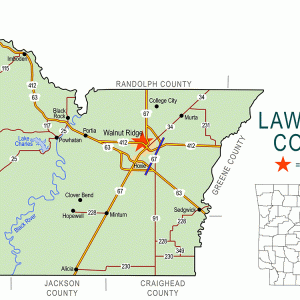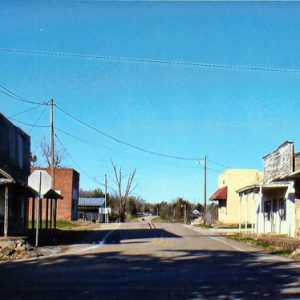calsfoundation@cals.org
Smithville (Lawrence County)
| Latitude and Longitude: | 36º04’49″N 091º18’13″W |
| Elevation: | 341 feet |
| Area: | 0.67 square miles (2020 Census) |
| Population: | 87 (2020 Census) |
| Incorporation Date: | January 10, 1851 |
Historical Population as per the U.S. Census:
|
1810 |
1820 |
1830 |
1840 |
1850 |
1860 |
1870 |
1880 |
1890 |
1900 |
|
– |
– |
– |
– |
– |
– |
– |
– |
– |
– |
|
1910 |
1920 |
1930 |
1940 |
1950 |
1960 |
1970 |
1980 |
1990 |
2000 |
|
– |
– |
– |
– |
– |
– |
89 |
113 |
86 |
73 |
|
2010 |
2020 |
|
|
|
|
|
|
|
|
|
78 |
87 |
|
|
|
|
|
|
|
Smithville was the first county seat of present-day Lawrence County. Though it is largely abandoned today, Smithville was once a thriving trading center near the Strawberry River in the foothills of the extreme eastern Ozarks region.
Louisiana Purchase through Early Statehood
The Nathaniel McCarroll family probably settled first in the area, around 1808. Other settlers joined them throughout the next several decades, most arriving from places such as Tennessee, Kentucky, North Carolina, and Missouri. By 1832, the area (then known as the Strawberry settlement due to the proximity of the Strawberry River) was populated enough to have the first post office erected within the modern boundaries of Lawrence County.
In 1837, the redrawing of county lines forced Lawrence County to move its county seat from Jackson (a town no longer extant that would be in present-day Randolph County near Imboden), and the town of Smithville was founded as the new location of county government. Smithville was named in honor of Colonel Robert Smith, a veteran of the War of 1812. He had made a donation to the county for building the new seat. A courthouse and an “escape-proof” jail were constructed—the latter with a floor of twelve-inch hewn logs and walls twenty inches thick—and the town quickly blossomed into an important trade center along the Military Road.
In 1838, an Oxford University professor, Dr. Charles Giles Bridle Daubney, ventured into Smithville en route from Little Rock (Pulaski County) to St. Louis, Missouri. Daubney wrote that Smithville “consist[ed] of about a dozen log huts, erected [a]round a sort of square, two of them stores, one of which comprehended a tavern for strangers.”
During the Mexican War, Company C, Arkansas Battalion of Infantry and Mounted Rifles was organized at Smithville on June 18, 1846. Though this company never saw action against Mexican enemies, many served at Fort Gibson in Indian Territory (present-day Oklahoma).
Civil War through the Gilded Age
Smithville resident Milton Dyer Baber was elected as one of Lawrence County’s two representatives to the Arkansas Secession Convention in March 1861, and he voted for “immediate secession.” Several companies were assembled and organized in Smithville, including the Seventh Arkansas Volunteer Infantry Regiment (CSA) on June 16, 1861, which consisted of 1,250 men. Most of the town’s and area’s volunteers served in the Trans-Mississippi Theater, such as the Battle of Wilson’s Creek in Missouri, though some saw action at such battles as Shiloh, Chickamauga, Atlanta, and Nashville.
A small skirmish occurred on a farm on the outskirts of Smithville on June 17, 1862, resulting in an apparent Union victory. The Union’s Fifth Illinois regiment reported two killed and four wounded in the action, while the Confederates suffered four wounded and fifteen missing (captured). Smithville was also susceptible to marauding jayhawkers and bushwhackers during the war. There was another skirmish near Smithville in 1864.
Arkansas’s Republican Reconstruction government lopped off the western part of the county to form Sharp County and ordered Lawrence County’s seat moved from Smithville to Clover Bend in 1868. Although steamboat commerce on the Black River in nearby Powhatan (Lawrence County) had already begun luring some of the area’s folks and business interests away from Smithville by the 1850s, the removal of the county seat leveled a huge blow upon the town. Between 1870 and 1880, Smithville’s population dropped from 1,144 to 350.
Early Twentieth Century through the Modern Era
Smithville continued to be a lively trading town for the surrounding area. Smithville even experienced a small and very short-lived “boom” as a mining community when veins of lead and zinc were discovered in the area in the 1890s. But the town “went bust” by the early twentieth century as the mines failed to turn profits. The county’s new railroad towns continued to drain the life of Smithville. Although the town was still a fairly lively trading center by the 1930s, the Great Depression and World War II proved to be watershed moments in its history. Many locals departed to serve in the military and to find better-paying jobs, never to return. The Works Progress Administration built a new school building in Smithville in 1936 (which was later converted into a community center), but the town’s dwindling population resulted in the school’s consolidation with Lynn Public Schools in 1946.
Smithville made national headlines in June 1983 in what became known as the “Smithville Shootout.” After a deadly shootout with federal marshals in Medina, North Dakota, on February 13, militant tax-protester and Posse Comitatus member Gordon Kahl fled to Arkansas, where Leonard and Norma Ginter harbored the fugitive in their house four miles north of Smithville on the Bill Wade farm. After Kahl was seen riding in a car that belonged to the son of the Ginters near Smithville, law officials organized a raid at the Ginter home. On June 3, armed officers surrounded the house after apprehending the Ginters, and Lawrence County Sheriff Gene Matthews, U.S. Deputy Marshal Jim A. Hall, and Arkansas State Trooper Ed Fitzpatrick entered the house. Matthews was struck with a fatal blast from Kahl’s high-powered rifle. The officers, including Matthews, made it out of the house, and a rifle barrage and tear gas were subsequently fired into the house. Officers eventually burned the house down, and Kahl’s charred remains were later discovered.
As Smithville headed into the twenty-first century, remaining locals continued efforts to eke out a living, but major highways, super centers, and major retail chains in larger towns and cities proved detrimental. In July 2008, Davis Discount General Store, then the town’s last full-time business, closed its doors. The once thriving town claimed a population of only seventy-eight in the 2010 census and has only a Methodist church, a Baptist church, a Masonic lodge, a post office, and three part-time businesses. As of 2010, the Old County Seat Store & Cafe was open for business on highway 115 in Smithville.
For additional information:
McLeod, Walter E. Centennial Memorial History of Lawrence County. Russellville, AR: Russellville Publishing Company, 1936.
Mother of Counties: Lawrence County, Arkansas, 1815–2001. Paducah, KY: Turner Publishing Company, 2001.
Perkins, J. Blake. “Peter Halderman, the Black Washingtons, and the ‘Southernization’ of the Ozark Foothills.” Arkansas Historical Quarterly 82 (Spring/Summer 2023): 48–72.
Ross, Margaret, ed. “Oxford Don Meets His First ‘Circuit Rider’ in 1838: Our First Description of Smithville.” Lawrence County Historical Quarterly (Winter 1983): 5–8.
“Shootout in a Sleepy Hamlet.” Time. June 13, 1983. Online at http://content.time.com/time/magazine/article/0,9171,951999,00.html (accessed September 27, 2022).
Wallis, Bilbrey Joe. “The History of Smithville: Sesquicentennial–1986.” Lawrence County Historical Journal (Spring 1996): 5–11.
Blake Perkins
Missouri State University
 Lawrence County Map
Lawrence County Map  Smithville Monument
Smithville Monument  Smithville Public School Building
Smithville Public School Building  Smithville Street Scene
Smithville Street Scene 



Comments
No comments on this entry yet.